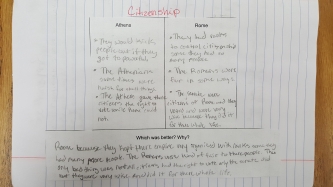
Well, slap my hand… I haven’t blogged in two months. I have been busy, but I wouldn’t have been so frazzled if I had taken the time to reflect, IN WRITING, about my busyness. So I will end the year with a post about the new year.
My #oneword2018 is dwell. It is a word that has come up in my workshop journey. I don’t remember the source (and don’t want to stop writing to search it out). I just need to do more “dwelling” and give my students time to do the same.
One of the sources of my “frazzle” is my focus. At times, I can get so many ideas in my head that I have difficulty sorting through them. I started using Google Keep to organize these ideas, but they can still get the better of me at times. This is all part of my tendency to rush – through everything. I think the urge to rush comes from my desire not to miss out on anything. It doesn’t help that we have 22 minute lunches. Or that I get nervous in a group setting and talk too fast, often butting in before the speaker is done.
So when my workshop cadre was discussing the need to dwell in thought before we speak or write, I immediately thought, yes! (I do see the irony in that statement.) If I am to dwell in 2018, I need to define what that word means for me and the actions I will take to live it.
Google’s dictionary lists three definitions. The first is to “live in or at a specified place”. Is that place my thoughts? If that is the case, I dwell to synthesize and understand those thoughts. Synonyms I like are reside, be settled, stay. This means I should be comfortable with my thoughts, but that can’t always be the case. Let’s continue.
The second definition is “think, speak, or write at length about (a particular subject, especially one that is a source of unhappiness, anxiety, or dissatisfaction)”. I don’t want to dwell on anything that causes me anxiety. But what that could mean, at least to me, is to dwell on the stuggle to comprehend. Dwelling in thought does not have to be overthinking if it is intentional and purposeful. I am getting closer.

 Summertime for teachers is like an intellectual mooring. The anchors, ropes, and cables that are used to hold us to our beliefs also give us the time and the place to reflect on the last year and prepare for the next. We do not cast off until our charges have arrived and we have prepped for the journey. This is my second year of workshop and we have a launching unit to help us get started. In the first couple of weeks we have had some wonderful moments I would like to share. A string of moments can grow into the momentum needed to sustain learning throughout the year.
Summertime for teachers is like an intellectual mooring. The anchors, ropes, and cables that are used to hold us to our beliefs also give us the time and the place to reflect on the last year and prepare for the next. We do not cast off until our charges have arrived and we have prepped for the journey. This is my second year of workshop and we have a launching unit to help us get started. In the first couple of weeks we have had some wonderful moments I would like to share. A string of moments can grow into the momentum needed to sustain learning throughout the year. and procedures. The point was to hit the students with an intriguing picture while demonstrating how we do things around here. Were we practicing thinking routines that would become a regular part of our classroom? Yes, both implicitly and explicitly. After making our thinking visible by recording our thoughts about Rahu in our notebooks, the students moved around the room exploring a gallery walk on the ancient myths and history of solar eclipses. I saw relaxed smiles as the students moved on to their next class. Mission accomplished.
and procedures. The point was to hit the students with an intriguing picture while demonstrating how we do things around here. Were we practicing thinking routines that would become a regular part of our classroom? Yes, both implicitly and explicitly. After making our thinking visible by recording our thoughts about Rahu in our notebooks, the students moved around the room exploring a gallery walk on the ancient myths and history of solar eclipses. I saw relaxed smiles as the students moved on to their next class. Mission accomplished.

 Summer. It’s time to relax, reflect, and reboot. And it’s time to do a couple of projects inside and out.
Summer. It’s time to relax, reflect, and reboot. And it’s time to do a couple of projects inside and out.



Recent Comments